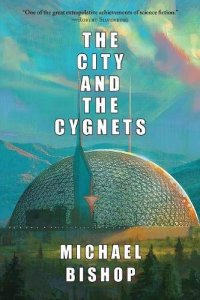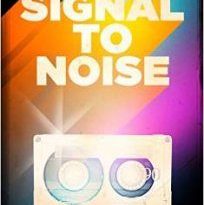Paul Di Filippo Reviews The City and the Cygnets by Michael Bishop
 The City and the Cygnets, Michael Bishop (Fairwood Press/Kudzu Planet Productions 978-1933846781, $19.99, 466pp, trade paperback) August 2019
The City and the Cygnets, Michael Bishop (Fairwood Press/Kudzu Planet Productions 978-1933846781, $19.99, 466pp, trade paperback) August 2019
Many authors can’t resist the temptation to revisit the work of their younger selves and do a little improving, while others subscribe to the famous verse by Omar Khayyám: “The Moving Finger writes; and, having writ,/Moves on: nor all thy Piety nor Wit/Shall lure it back to cancel half a Line,/Nor all thy Tears wash out a Word of it.” Like a loving owner tending an old house in need of a few modernizations, the authors who indulge in reworkings of previously printed books can exhibit either a commendable desire for subtle updates and repairs, or else a wild impulse to gut the place and rebuild from the naked joists out.
Michael Bishop has shown in the past that he is the more cautious and responsible and respectful kind of fixer-upper, having gently revised early books of his like A Funeral for the Eyes of Fire. And with this new project he has achieved a subtly revamped version that balances his youthful fervor and vision with mature artistic insights. Amalgamating all his Urban Nucleus stories about a future alien-influenced Atlanta (Catacomb Years) with the lone novel set in that continuum (A Little Knowledge), The City and the Cygnets represents a fixup of much power and grace. In terms of its themes, treatment and timeliness, it stands shoulder to shoulder with major works just released in 2019.
Set inside the domed city of Atlanta on a timeline that is now presented as parallel to ours, rather than the possible anticipated future itself, these stories from 1970 to 1978 are among Bishop’s earliest (he hit the scene in 1970). But they already show immense craft and ambition. While it’s a little disconcerting—for those of us who read them the first time around—to see references to CDs, DVDs, cell phones, e-comics and PCs, these minor updates are nicely interleaved and soon fade into the background.
The solid, Heinleinian future history linking these pieces (we cover not quite a century) is deployed in interstitial passages, and builds up a very convincing scenario of societal fragmentation, repression and countercultural blowback—very topical themes as the Sixties segued into the Seventies, and also again today. And in the heyday of Buckminster Fuller and Paolo Soleri, domed cities were all the rage, lending Bishop’s scenario more heft at the time. Others played with this concept. Consider Silverberg’s The World Inside (1971) as cousin to this book—a linkage affirmed by Bishop in his “Afterword.”
Additionally, another contemporaneous role model for The City and the Cygnets—a masterpiece seldom imitated or followed—is Tom Disch’s 334, that slice-of-life portrait of a subset of New York City dwellers. Bishop admits he used Disch’s template generously and knowingly. But he adds his own depth and patina.
A loving and attentive introduction by Kelly Robson slides us nicely into the text.
“If a Flower Could Eclipse” lays out some of the racial and class tensions inside the dome, as we see the fraught and complex relations between a child prodigy (Emory Coleman) and his teacher (Fiona Bitler). “Old Folks at Home” has a Delanyesque good time examining the intricacies of a formal marriage amongst multiple partners. (The creator of this system, Leland Tanner, will help close out the saga.) Echoes of Bradbury inform “The Windows in Dante’s Hell”, where a dead old woman’s attempt to make domed life palatable is seen by outsiders as mere waste and frivolity, and sent down for burning. “The Samurai and the Willows” chronicles the quirky friendship between a young black woman, Queequeg, and an older bonsai-loving man nicknamed Basenji.
“Allegiances” brings us roughly to the halfway point in the text, as an expedition leaves the city to track down the missing student-teacher duo from the first story. They do find the pair, who have returned from exile abroad, many years later, with aliens in tow, the cygnets. “A face carved from maple or mahogany…two upright ridges between eyes and lips, two hooded eyes with large hourglass-shaped pupils…” They plan to introduce the aliens into Atlanta, and succeed. This brings us to the short and funny “At the Dixie-Apple with the Shoofly-Pie Kid”, wherein an alien’s public appearance in a crass commercial venture causes a circus of chaos.
Now is inserted the entire novel, A Little Knowledge. Rich with an enormous cast from all strata of the domed keep, the tale is carried mainly on the shoulders of Julian Cawthorn, aspiring twenty-one-year-old writer. His fate lands him the job of liaison to the aliens, and he finds himself catnapping felines for their pleasures, as well as navigating the fraught relations between humans and the cygnets. The aliens seem to want to convert to the dominant Ortho-Urban Christian religion of the city, and vast debates and skirmishes result. The book culminates with their conversion and shows us the resulting fallout, as well as giving us Julian newly matured, settling down in marriage to his love Margot.
“We’re recipients of revelation [said Julian]. Like Saint John, like Muhammed, like Joseph Smith. How must we react? What must we do?”
“Revelation doesn’t change who we are. We still have our lives and souls, Julian. I don’t feel like a prophet.”
Very Blishian, and indeed Chapter 29 of the novel is titled “Cases of Conscience”. And does Julian’s Kid-like passage through his city hark a bit to Dhalgren? Perhaps!
The coda to the book, “Death Rehearsals”, proves that life does go on after such grand moments, as we jump ahead a couple of years and follow Julian, Margo, and Leland Tanner through the ultimate transmogrification of the city.
Throughout the book Bishop does a masterful job of juggling several major components of the novel. I’ll cite them, but not in the actual order of their narrative importance. First is the sheer physicality of the city. He never lets you forget the strange environment, which he conjures up in full tactility.
Julian traveled down to Level 4, that underground network of corridors, open courts, grottoes, and hidden bazaars. He passed prayer booths, tattoo parlors, tress-sculpting emporia, everything. He even saw on display acrylic portraits, on nappy black velvet, of the Hyatt Regency starmen.
Second comes the welter of different personalities, all unique and clarified with delicate but forceful touches, and their complex interactions, even across generations. Third are the societal trends evolving from the cloistered prisonlike way of living, the roller-skating glissadors and the antisocial hoisterjacks and so forth. Finally comes all the metaphysical themes with their striking objective correlatives, the cygnets primarily. These pieces revolve around and through each other like a Calder mobile.
Given that this fiction represents the work of a relative youngster just feeling his oats, one can detect perhaps a smidgen too much of intricate formalism, a desire to cram as much into the bag of the novel as possible, and a mighty wrestling with eternity. But these are always the marks of youth, and many young writers flame out because they rely solely on such technicolor whizbangs. But The City and the Cygnets has a core of more solid and useful humanity and compassion, exhibiting the author’s sheer joy and interest in the matter of living, and was a true prophecy of a long fruitful career ahead. In its new guise, the book is both foundation stone and capstone to all the great tales Bishop has wrought.
 While you are here, please take a moment to support Locus with a one-time or recurring donation. We rely on reader donations to keep the magazine and site going, and would like to keep the site paywall free, but WE NEED YOUR FINANCIAL SUPPORT to continue quality coverage of the science fiction and fantasy field.
While you are here, please take a moment to support Locus with a one-time or recurring donation. We rely on reader donations to keep the magazine and site going, and would like to keep the site paywall free, but WE NEED YOUR FINANCIAL SUPPORT to continue quality coverage of the science fiction and fantasy field.








A wonderful book! The author has done a fine job of bringing together and updating two of my favourite books from the 1970s.